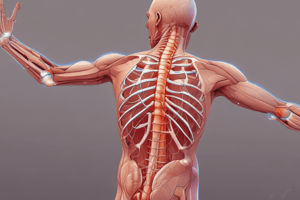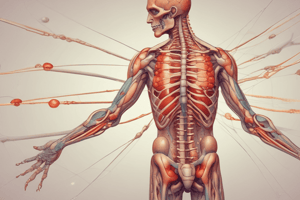Podcast
Questions and Answers
What is the result of tissue damage in inflammatory pain?
What is the result of tissue damage in inflammatory pain?
- Desensitization of nocipetors to noxious stimuli
- Decreased activity of low-threshold mechanoreceptors
- Increased production of prostaglandins (correct)
- Reduced sensitivity of nocipetors to noxious stimuli
What is the term for hypersensitivity to a noxious stimulus?
What is the term for hypersensitivity to a noxious stimulus?
- Hypersensitivity
- Analgesia
- Hyperalgesia (correct)
- Allodynia
What type of stimuli can cause pain in sensitized individuals?
What type of stimuli can cause pain in sensitized individuals?
- Only noxious stimuli
- Neither noxious nor non-noxious stimuli
- Only non-noxious stimuli
- Both noxious and non-noxious stimuli (correct)
What is the mechanism of action of NSAIDs in reducing pain?
What is the mechanism of action of NSAIDs in reducing pain?
Which type of receptors are involved in allodynia?
Which type of receptors are involved in allodynia?
What is the role of prostaglandins in inflammatory pain?
What is the role of prostaglandins in inflammatory pain?
What is the term for pain that results from a non-noxious stimulus?
What is the term for pain that results from a non-noxious stimulus?
What is the effect of sensitization in the pain pathway?
What is the effect of sensitization in the pain pathway?
What is the source of inflammatory mediators in inflammatory pain?
What is the source of inflammatory mediators in inflammatory pain?
Why are NSAIDs effective in reducing pain?
Why are NSAIDs effective in reducing pain?
Study Notes
Inflammatory Pain
- Tissue damage releases inflammatory mediators, including prostaglandins and bradykinin, which increase the sensitivity of nociceptors to noxious stimuli.
- This process leads to sensitization in the pain pathway, resulting in hyperalgesia (hypersensitivity to noxious stimuli).
- Hyperalgesia is characterized by hypersensitive nociceptors.
- In addition, inflammatory pain can cause allodynia, which is pain resulting from a non-noxious stimulus.
- Allodynia is mediated by the activation of low-threshold mechanoreceptors and thermoreceptors.
- NSAIDs (non-steroidal anti-inflammatory drugs) reduce the production of prostaglandins, which contributes to the alleviation of inflammatory pain.
Inflammatory Pain
- Tissue damage releases inflammatory mediators, including prostaglandins and bradykinin, which increase the sensitivity of nociceptors to noxious stimuli.
- This process leads to sensitization in the pain pathway, resulting in hyperalgesia (hypersensitivity to noxious stimuli).
- Hyperalgesia is characterized by hypersensitive nociceptors.
- In addition, inflammatory pain can cause allodynia, which is pain resulting from a non-noxious stimulus.
- Allodynia is mediated by the activation of low-threshold mechanoreceptors and thermoreceptors.
- NSAIDs (non-steroidal anti-inflammatory drugs) reduce the production of prostaglandins, which contributes to the alleviation of inflammatory pain.
Studying That Suits You
Use AI to generate personalized quizzes and flashcards to suit your learning preferences.
Description
This quiz covers the effects of tissue damage on pain sensitivity, including the release of inflammatory mediators and the resulting sensitization of nociceptors, leading to hyperalgesia and allodynia.




